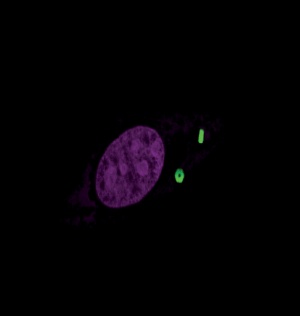Aug 5 2008
In the budding field of nanotechnology, scientists already know that size does matter.
 image of PRINT® nanoparticles
image of PRINT® nanoparticles
But now, researchers at the University of North Carolina at Chapel Hill have shown that shape matters even more — a finding that could lead to new and more effective methods for treating cancer and other diseases, from diabetes and multiple sclerosis to arthritis and obesity.
A team of researchers led by Joseph DeSimone, Ph.D., Chancellor's Eminent Professor of Chemistry in UNC's College of Arts and Sciences and William R. Kenan, Jr. Distinguished Professor of Chemical Engineering at North Carolina State University, and Stephanie Gratton, a graduate student in DeSimone's lab, have demonstrated that nanoparticles designed with a specific shape, size and surface chemistry are taken up into cells and behave differently within cells depending on these attributes.
Their findings appear in this week's online early edition of the journal PNAS, the Proceedings of the National Academy of Sciences.
Using nanoparticles to combat cancer is an area of interest for many researchers. For decades, treating the disease has mostly involved injecting patients with toxic drugs – a practice in which only a fraction of the drugs reach the intended target, killing healthy cells in the process and causing harmful side effects.
Previous studies have shown that drug-carrying nanoparticles can hone-in on and attack tumors, in part because of their extremely small size — less than 100 nanometers (one nanometer = one billionth of a meter) — which helps allow them to pass through cell membranes. However, up until now, existing techniques have meant that targeting agents could only be delivered using spherical or granular shaped particles.
Using PRINT® (Particle Replication in Non-wetting Templates) technology — a technique invented in DeSimone's lab that allows scientists to design and produce "custom-made" nanoparticles — the UNC researchers made particles with specific shapes, sizes and surface charges. DeSimone said the aim is to optimize particle attributes for specific therapeutic objectives.
"This would mean that we could deliver lower dosages of drugs to specific cells and tissues in the body and actually be more effective in treating the cancer," said DeSimone, who is also a member of UNC's Lineberger Comprehensive Cancer Center and the co-principal investigator for the Carolina Center for Cancer Nanotechnology Excellence.
Creating particles of different dimensions, the UNC researchers changed one variable at a time, and experimented with different surface chemistries. They then incubated the different particles with human cervical carcinoma epithelial (HeLa) cells, monitoring each type to see which ones the cells absorbed most effectively.
For instance, the scientists discovered that long, rod-shaped particles (diameter, 150 nanometers; height, 450 nanometers) were internalized by cells approximately four times faster than lower aspect ratio particles (diameter, 200 nanometers; height, 200 nanometers), and traveled significantly further into the cells as well.
Gratton noted the same phenomenon is found in natural organisms.
"The long rod-shaped structure of bacteria may help explain why PRINT® particles of higher aspect ratios are internalized more rapidly and effectively than lower aspect ratio particles," she said. "If we can design particles that rely on the same mechanisms that nature has perfected for bacteria, we may unlock the key for delivering therapeutics more efficiently and effectively to treat and cure disease."
Liquidia Technologies, a UNC spin-off company, has an exclusive license to the PRINT® technology and is developing engineered nanoparticles for delivery of nucleic acids and small molecule therapeutics. Liquidia also sponsors research in the DeSimone lab. The company's chief executive officer, Neal Fowler, said the study's findings should prove of interest to the biopharmaceutical industry.
"We are delighted to contribute to the important work that Professor DeSimone and his students are undertaking in the field of nanomedicine. This work answers key questions about the role of particle shape and size that industry leaders have been asking for some time," Fowler said.
The study was funded by the National Science Foundation, the National Institutes for Health, the Carolina Center for Cancer Nanotechnology Excellence, the William R. Kenan Professorship and Liquidia Technologies.
Other UNC researchers who contributed to the study are Patricia Ropp, Ph.D., Patrick Pohlhaus, Ph.D., Christopher Luft, Ph.D. and Mary Napier, Ph.D., from the chemistry department and the Carolina Center for Cancer Nanotechnology Excellence, along with Victoria Madden, Ph.D., from the School of Medicine's pathology department.